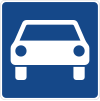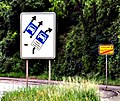Motorway
As a dual carriageway (colloquially motorway or fast road called) is one in Germany highway designated. As a public road, it is intended exclusively for motor vehicles whose design-related maximum speed exceeds 60 km / h. The height of the vehicles may be a maximum of four meters and the width a maximum of 2.55 m (refrigerated vehicles 2.6 m) ( § 18 Road Traffic Regulations StVO). (Even an inner-city tunnel, in which you are allowed to drive a maximum of 50 km / h and which is designated as a motor road, is only allowed to drive if you could drive more than 60 km / h.)
The signs 331.1 and 331.2 are used wherever only fast motor vehicles are supposed to run.
The usual speed limits according to § 3 StVO apply on motorways , unless there are corresponding signs indicating a higher or lower speed limit. On motorways and other roads whose directional lanes are structurally separated from each other, outside of built-up areas - as long as this is not restricted by a traffic sign - such as on motorways, “driving so fast that you can keep within the overlooked route”. The same applies to motorways and other roads that have at least two lanes marked by lane delimitation (sign 295) or by guidelines (sign 340) for each direction.
Such unrestricted motorways exist z. B. in the Flensburg area, in the southern Harz on the B 27 and on the feeder ( B 33 ) from the A 81 to Konstanz on Lake Constance, here even on long sections. Upgrading to motorways as in the case of the A 36 and A 369 is possible.
For trucks , trains with trailers, motorcycles and buses , the speed restrictions apply as for motorways in accordance with Section 18 of the StVO, provided that the directional lanes are structurally separated. This only applies to motorways, not to equally developed country roads, i.e. also not to motorway-like federal roads that are not designated as motorways. In order for the regulation in § 18 to take effect on motorways, according to the court ruling, a mandatory condition is a structural, even physical, separation of the directional lanes that makes driving over difficult.
In contrast to motorways , motorways can be crossed by other roads at the same level . The traffic at junctions is then mostly regulated by traffic lights or roundabouts .
Turning on motorways is forbidden according to § 18 StVO as well as on motorways, as is stopping, even on hard shoulders. Pedestrians are only allowed to cross motorways at intersections, junctions or designated points (but before which the motorway is generally terminated), but otherwise not enter.
Bundesstraße 2 as a motor road with separate lanes at Farchant
Transition from motorway to motor vehicle ( Bundesautobahn 60 )
Sections of the B 36 are open to agricultural traffic.
Similar designs
- Motorway (other countries)
- to demarcation: motorway-like road




